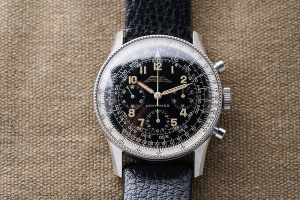Breitling Navitimer 806
Brief History
The Breitling Navitimer is an evolution of the 1942 Breitling Chronomat, with its typical slide rule bezel. Breitling decided to improve this highly practical bezel and in 1952, the ‘Navi’ was born. This slide rule bezel was used to calculate complicated operations without any other tool. The 1942 Chronomat came with an out-sourced movement, the Venus 176. It was used by the United States Air Force.
1952: the very first Navitimer wore the “Aircraft Owners and Pilots Association” (AOPA) emblem on its dial (the typical double-wing logo) and by 1960, a real cooperation with the AOPA began. The “Navitimer” name is the contraction of “navigation” and “timer”. The first edition to be sold was the reference 806, powered by a manual chronograph movement with column wheel mechanism, the Venus 178.
1954: the 806 was equipped with a Valjoux 72 (the same movement as the vintage Rolex Daytona) and thus, are among the most collectible.
Willy Breitling, helped by the Swiss advertiser Georges Caspari, developed a campaign that targeted groups of pilots and that created a huge demand for navigation chronographs. Furthermore, Breitling continued to be the official supplier of board instruments for all the major aircraft companies – as for example the 1957 Boeing 707, equipped with Breitling dashboard instruments.
At the end of the 1960s, Breitling chose to change the Venus 178 with a Valjoux 7740, a manually wound movement, cam-operated with a date feature. An automatic chronograph movement would follow in 1969.
The man behind the development of this new calibre was Gérald Dubois, who was working for Dépraz & Cie (now famous with the name Dubois Dépraz). Using a base calibre from Buren (a thin automatic movement with a micro-rotor), Dubois worked together with Jack Heuer and Willy Breitling to develop this brand new idea of an automatic chronograph. And that cooperation led to the creation of a modular chronograph mechanism, added on the top of the Buren calibre (for that reason, the integrated micro-rotor is invisible). The legendary Calibre 11 was born. One very unique feature of this movement is its left-positioned crown (the pushers are, as usual, located on the right side of the case). The introduction of this movement changed massively the face of the Navitimer that moved from a tri-compax layout to a bi-compax with date at 6 o’clock configuration. See also the Heuer Monaco for use of this movement.
Pre806 AOPA model
The first Navitimers ever produced were intended for the sole use by members of the Aircraft and Pilot Association (commonly referred to as the AOPA). They do not bear any reference numbers on the caseback, and were produced for only one year, from late 1954 until 1955. These are incredibly rare and highly prized by collectors. This “pre-806”, as it is called by collectors, is powered by the much-lauded Valjoux 72 manually wound chronograph movement.
The beaded bezel, made for gripping with a leather glove whilst making in-flight calculations, features smaller beads (about 125 beads to be exact) than later iterations. They were marketed directly to AOPA members for the grand sum of $87.50. This early iteration and its immediate successor both have “all black” dials, as future Navitimers would have contrasting subdials, another signature from Breitling chronographs meant for further improving legibility.
The First 806
In 1956, wishing to capitalize on the Navitimer’s success within the aviation community, Breitling released what was now called the reference 806. Instead of a Valjoux 72 movement, the 806 housed a Venus 178 manually-wound chronograph movement, which would continue to be used until the early 1970s. Still with black subdials, the reference 806 otherwise had several dial variations, as Breitling experimented with new markets and layouts.
These include the AOPA signed wings of the early 806, a configuration only meant for the American market, unsigned wings and the Breitling logo, and a Breitling – Genève – wings combination. The actual Breitling signature only became present on the dial in the late 1950s, so early iterations of the reference 806 do not display the manufacture. The beads on the bezel got larger and decreased in number, likely to increase friction. Advertisements of the era bill the Navitimer as the “chronograph of the future” and declared unequivocally that “the Navitimer is your co-pilot.” Bringing a more luxurious touch to this pilots' instrument, a gold-plated version was also made, as well as an extremely rare execution crafted in solid gold.
Links
Credits - https://www.phillips.com/article/37929545/breitling-navitimer-the-early-years

